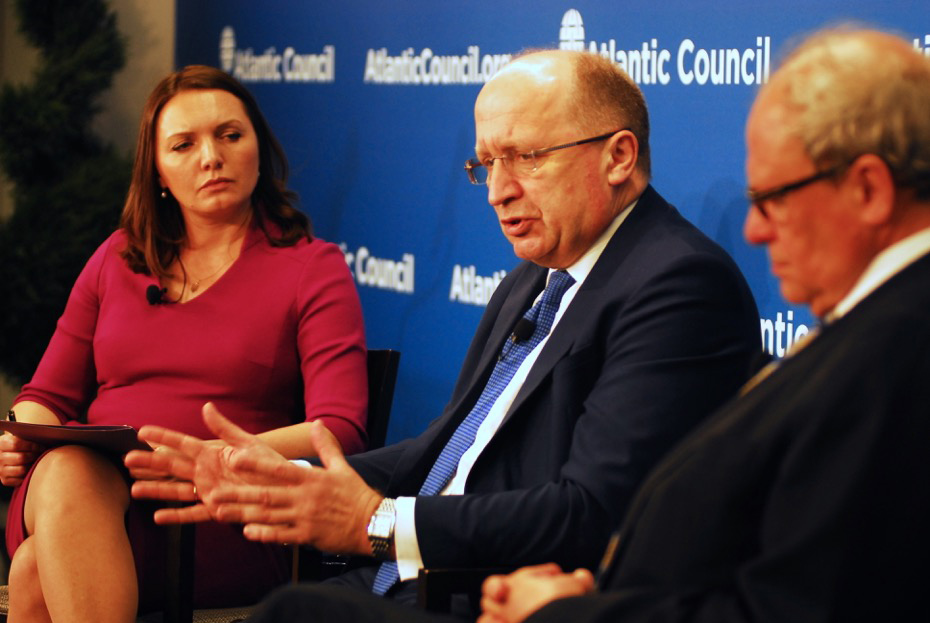
Ukraine Can Learn from Baltic States’ Experience with Reforms, says Lithuania’s Ex-Prime Minister
As it struggles to fix its economy, Ukraine would do well to study the reforms successfully implemented by three fellow former Soviet republics in the Baltics, Andrius Kubilius, Lithuania’s former Prime Minister said April 16 at the Atlantic Council.
“I was Prime Minister twice, on both occasions during a quite difficult economic crisis in Lithuania,” said Kubilius who led his country from 1999 to 2000 and again from 2008 to 2012. “Perhaps I have some knowledge what to do during a crisis, but not so much on what to do when life is beautiful.”
These days, life is hardly beautiful for Ukraine’s 42 million inhabitants. Its economy is a mess, and that’s not just because of Russia’s 2014 annexation of Crimea and its continuing support for separatists in eastern Ukraine.
Endemic corruption, a bloated public sector, and a refusal to adopt much-needed reforms put the Ukrainian economy into a tailspin long ago, said Anders Åslund, a Swedish economist and Senior Fellow at the Peterson Institute for International Economics.
Kubilius said the prospect of membership in the European Union and NATO encouraged Estonia, Latvia, and Lithuania to make the painful sacrifices necessary to emerge from the post-Soviet era.
“We were promised quite early, in the mid-1990s, that if we made all the reforms, we’d be accepted as members of the EU and NATO. That kept us on track,” he said. “It allowed us to move ahead with our reforms, despite all our political mistakes and stupid decisions.”
But that was when Russia’s President was Boris Yeltsin, not Vladimir Putin. Things are different now, he warned—and only massive US and European assistance to Ukraine will avert a long-term crisis.
Kubilius and Åslund participated in a discussion hosted by the Atlantic Council’s Dinu Patriciu Eurasia Center. Myroslava Gongadze, a journalist with Voice of America’s Ukrainian-language service, moderated the panel. The event coincided with the release of Åslund’s new book, Ukraine: What Went Wrong and How to Fix It.
Another 25 years of Putin?
Kubilius predicted Putin would stay in power for at least the next two decades.
“There will be no constitutional obstacle. The only question will be his personal health, and being in his sixties, Putin can dream of staying in power until the age of 80 or 85. The economy will go down and he will become more aggressive,” he said.
The former Lithuanian leader said Putin’s long-term strategy is to prevent Ukraine from reforming its own economy and then use the ensuing unrest as a pretext for annexing the entire country.
“His major goal is to create chaos and dissatisfaction among the people in order for Putin to come back and take over the whole territory of Ukraine,” he warned. “That’s why we in the West need to have our own strategy to prevent him from succeeding—not only military assistance to defend Ukrainian territory but also assistance with economic reforms. It’s the only way we can positively influence developments in Russia itself.”
Yanukovych’s downfall
Ukraine’s former President Viktor Yanukovych won free and fair presidential elections in February 2010, with only 49 percent of the vote, but then squandered that support by abolishing the constitution on October 1, 2010, and stealing parliamentary elections in October 2012, said Åslund.
“These were the worst elections in Ukraine’s post-communist history,” he said. “He embezzled billions from the state and had more than one hundred people killed. That’s what finished him.”
The irony is that Ukraine is deeply corrupt but relatively free compared to the post-Soviet authoritarian regimes of Central Asia. Even so, from 1992 to 2013, its per-capita GDP rose less than 50 percent—the smallest increase of any of the fifteen former Soviet republics.
According to the International Monetary Fund (IMF), Ukraine’s GDP fell by 6.8 percent in 2014 and will shrink another 5.5 percent this year before recovering in 2016, when GDP will rise by 2 percent.
“Visiting Ukraine now for me is like going back to what we experienced in the early 1990s,” said Kubilius. “Sometimes I joke that reforms only start when the monuments are removed. We got rid of our Lenin and Stalin monuments in 1991. In Ukraine, they are doing this only now.”
A long way to go
On March 11, the IMF approved a four-year stabilization program of $40 billion worth of credits, $17.5 billion of which is to come from the IMF itself. This announcement followed the passage by Ukraine’s parliament of eight economic reform laws that the IMF had set as a precondition for its support.
Two years ago, public pensions still ate up 18 percent of Ukraine’s GDP, compared to 5 percent in the United States.
“These pensions were largely going to the wrong people. Young people shouldn’t have pensions,” Åslund said. “Since then it has dropped to 14 percent of GDP, which is a start but it’s still not enough.”
Indeed, Ukraine still has a long way to go. Åslund, who helped establish the Stockholm Institute of East European Economics, called for the “whole-scale sacking of public officials” throughout Ukraine.
“If you don’t get rid of them, you can’t reform the state,” he warned. “Unfortunately, only two thousand of them have been sacked. It’s too few. And if you have a thoroughly corrupt judiciary as Ukraine has, then you can’t use the judiciary for the cleansing. It has to be done by other means, as it was done in East Germany.”
Larry Luxner is an editor at the Atlantic Council.
Image: Andrius Kubilius (center), former Prime Minister of Lithuania, and Anders Åslund (right), a Swedish economist and Senior Fellow at the Peterson Institute for International Economics, participated in a discussion April 16 organized by the Atlantic Council’s Dinu Patriciu Eurasia Center. Myroslava Gongadze (left), a journalist with Voice of America’s Ukrainian-language service, moderated the panel. (Atlantic Council/Larry Luxner)
